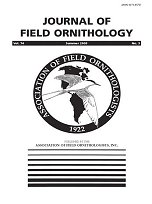We designed a simple experiment to investigate whether the use of diurnal tape-lures could affect the composition of mist-netted samples of wintering Chiffchaffs (Phylloscopus collybita). It was found that use of spring-song tape-lures introduced a highly significant bias of the sex ratio (more males were attracted) but not the age ratio or body condition of the birds. A comparison with results from other studies and species suggests that the use of spring-song tape-lures introduce biases that are varied and difficult to predict.
BioOne.org will be down briefly for maintenance on 14 May 2025 between 18:00-22:00 Pacific Time US. We apologize for any inconvenience.
How to translate text using browser tools
1 July 2003
Diurnal tape-luring of wintering Chiffchaffs results in samples with biased sex ratios
Miguel Lecoq,
Paulo Catry
ACCESS THE FULL ARTICLE
It is not available for individual sale.
This article is only available to subscribers.
It is not available for individual sale.
It is not available for individual sale.

Journal of Field Ornithology
Vol. 74 • No. 3
July 2003
Vol. 74 • No. 3
July 2003
age
mist nets
Phylloscopus collybita
Portugal
Sylviidae




